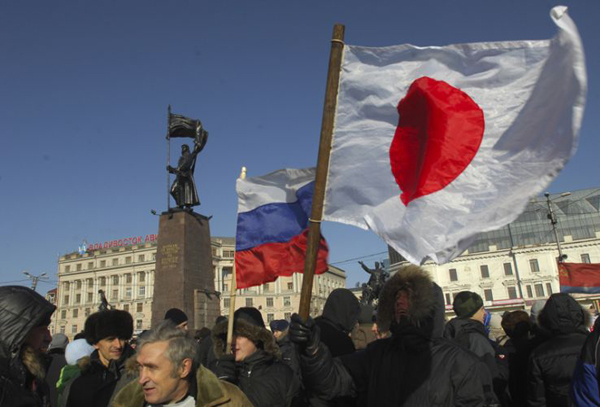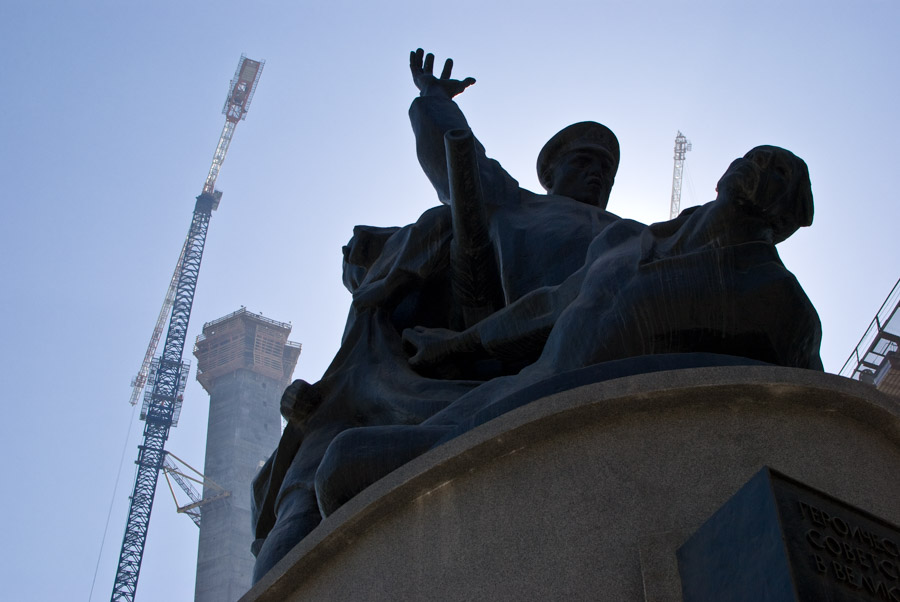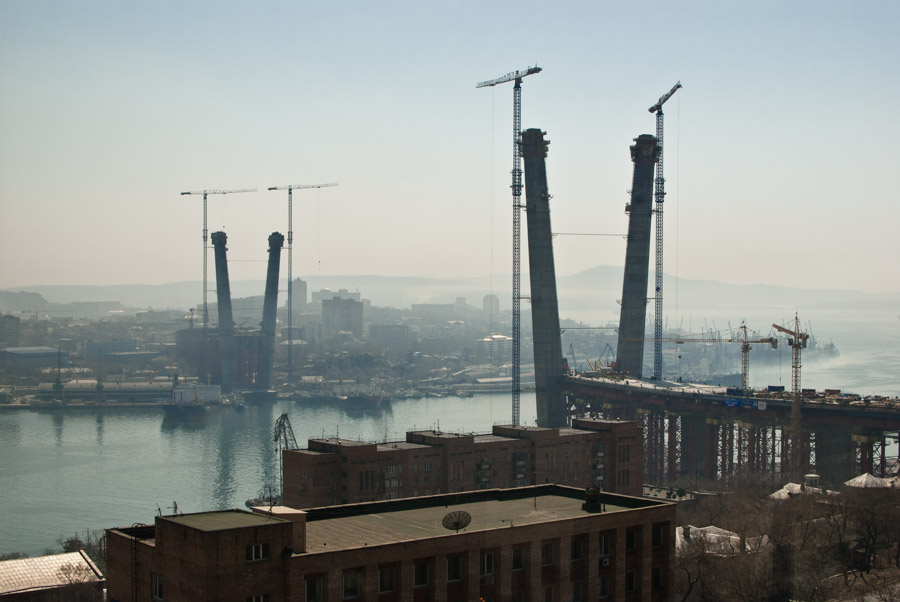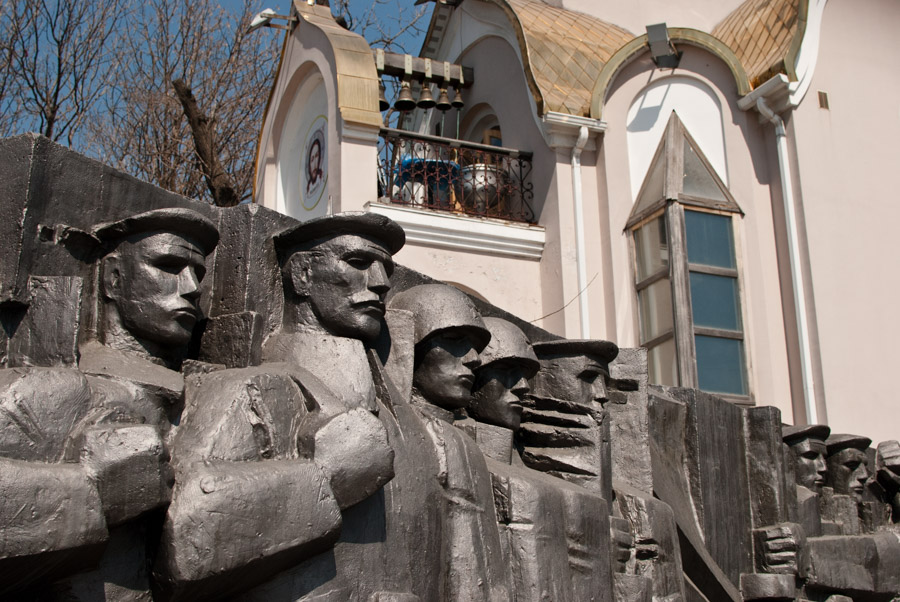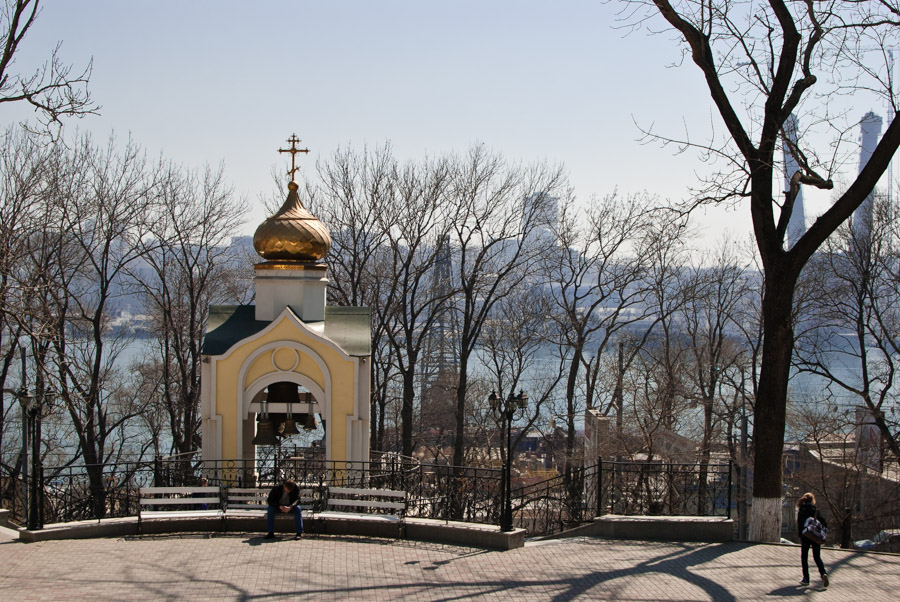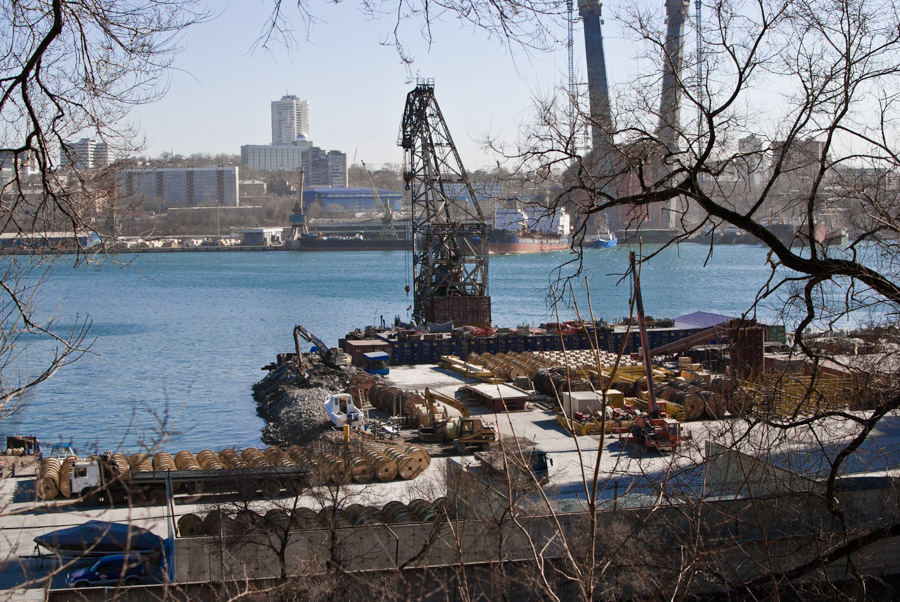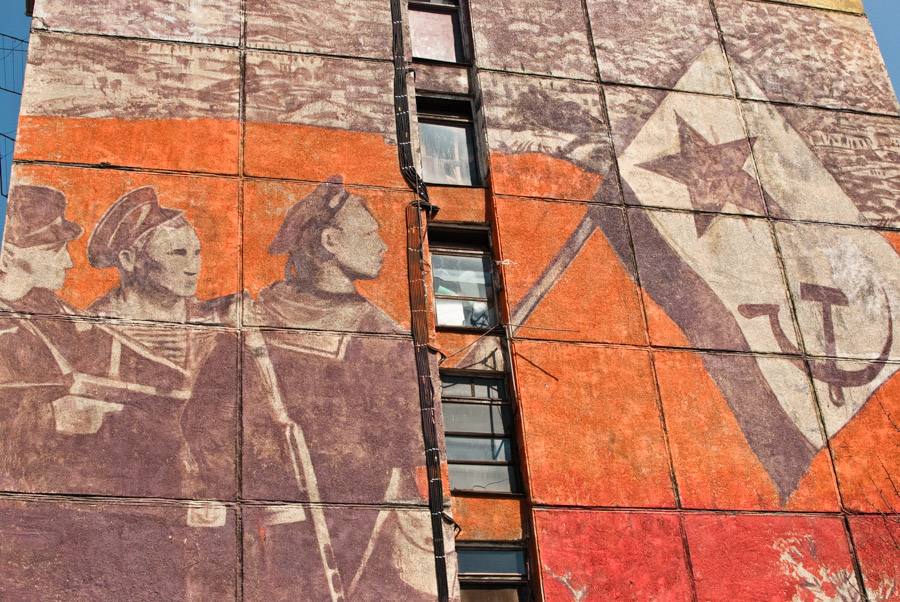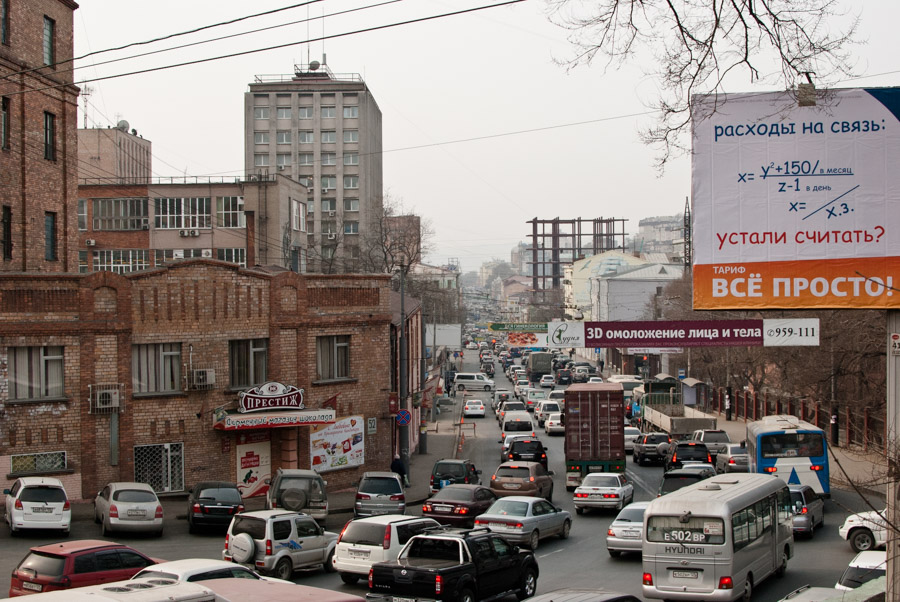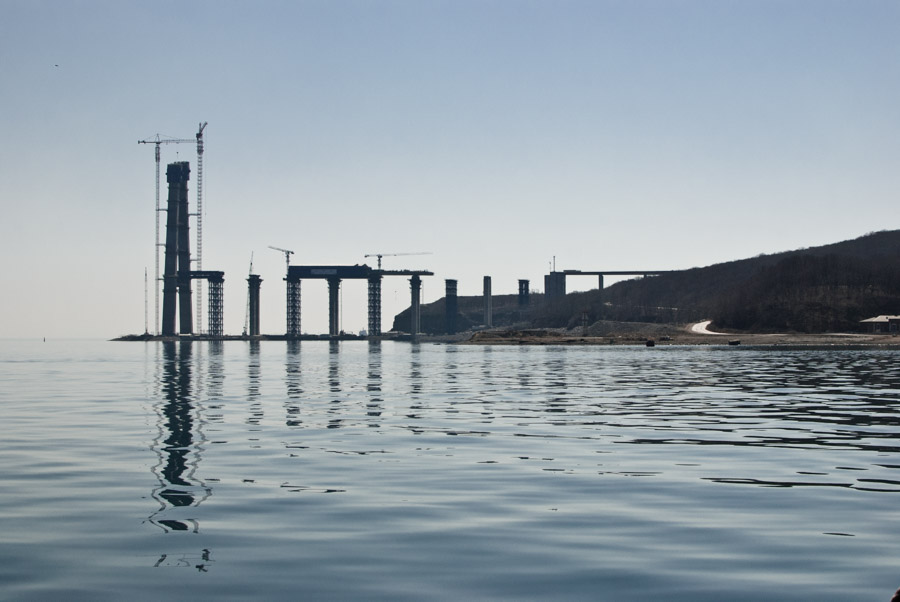Vladivostok, a Pacific port city long in decline, is being revitalized by Moscow. But the city’s slow integration with China, Japan, and South Korea is clashing with its long-Slavic identity. Can a city be both European and Asian?
At its eastern fringe, 4,000 miles from Moscow, Russia is building a bridge to nowhere. Two giant pairs of concrete support pylons tower over the glassy waters of the Eastern Bosphorus strait, the first stage of a project that will link the port city of Vladivostok to Russky Island. The scrub-covered island is mostly empty, home to just a few thousand grizzled residents and a collection of moldering military barracks. Basic infrastructure — sewers, roads, electricity — is largely non-existent.
Upon completion, Russian state media are ever keen to point out, the Russky Island Bridge will be the longest cable-stayed suspension bridge in the world, spanning 1,104 meters. On the island itself, there are plans to build hotels, a university campus, and facilities for hosting next year’s Asia-Pacific Economic Cooperation (APEC) summit.
The federal government in Moscow has billed the September 2012 summit as something of a coming-out party for Vladivostok, the largest city in the Russian Far East and the home of Russia’s Pacific Fleet. The formerly neglected region is awash with cash. A total of 426 billion rubles (just over $15 billion) is being poured into the Primorsky region ahead of the summit — an amount equivalent to 60 times Vladivostok’s annual city budget. Highways leading into the city are being chewed up and expanded; in addition to the Russky Island bridge, another massive suspension bridge is reaching out across the Golden Horn Bay, the hook-shaped inlet in the city center.
The huge injection of cash represents Russia’s renewed attention towards its Far Eastern territory, a region long plagued by neglect and economic stagnation. In Soviet times, the vast region — four-fifths the size of Australia — was heavily propped up by state subsidies, but as Asia’s economies have boomed, the region has fallen into precipitous decline.
The once-proud Pacific Fleet has shrunk to a fraction of its size, while a large part of the region’s defence industries, the lifeblood of many towns and cities, have long ceased production. In their place, corruption has flourished. David Satter, a Russia expert at the Johns Hopkins University School of Advanced International Studies, told me that in the years after 1991 the Primorsky region was subject to “criminal looting” under the governorship of Evgeny Nasztradenko, a former Soviet official backed by powerful local oligarchs. “During the 1990s, it was the most criminalized enclave in the whole country,” Satter said. “It became a law unto itself.”
Low fertility, high death rates, and collapsing infrastructure added to the rot, leaving much of the region barren. The population of Vladivostok, the capital of the Primorsky region, has contracted from a peak of 648,000 in 1991 to 578,000 last year, while the population of the Far East as a whole has dropped from 8.05 million to just 6.44 million, according to official statistics.
“There was a huge system that provided employment, money, and everything for this region, but the market reforms happened, and the plants stopped work and the population started moving,” said Alexandr Latkin, an economist at the Vladivostok State University of Economics and Service, a major institution here. The exodus has included some of the region’s best and brightest. As one recent analysis of the Far East put it, the intellectually vibrant Vladivostok of Soviet times has turned into “an ordinary provincial city where uncouth and boorish traders dealing in used Japanese cars now set the tone”.
“This is why the Russian government is putting huge amounts of money into the Far East and into Vladivostok,” said Latkin. “They want to bring back the status of the Far East that was lost during the ’90s.”
• • • • •
Vladivostok, which means “Lord of the East” in Russian, began its life in 1859 as a naval outpost on the periphery of the Russian Empire, and became the main garrison in the Tsar’s newly-acquired Pacific territories. There has always been something geographically implausible about the city: it teeters on the edge of the Eurasian landmass, separated from Moscow by thousands of miles of largely uninhabited wilderness, sustained for many years via the single narrow artery of the Trans-Siberian Railway. The distance encompasses seven time zones; when Muscovites are sitting down for lunch, easterners are drawing their shades.
The first thing that strikes visitors to Russia’s Pacific capital is how defiantly Russian it looks. The imperial-era heart of the city stretches out along an axis formed by Svetlanskaya and Aleutskaya Streets, running north and east along the Golden Horn Bay like diminutive copies of St. Petersburg’s Nevssky Prospekt. Where the two boulevards meet, gazing over the glittering Sportivnaya Harbor, is a symbol of a more recently departed empire: a towering plinth of white marble housing the headquarters of the regional administration. This monstrous edifice — ironically termed the “White House” by locals — dwarfs the rather more moth-eaten “Pentagon” that sits nearby: the longtime nerve center of the Russian Pacific Fleet.
For years, Vladivostok was a closed military city, and few foreigners were allowed to settle there. (One of the city’s first foreign restaurants was opened by the North Korean government, then on friendly terms with Moscow). Though China is just five hours away by car, there are surprisingly few Asian faces to be seen on the city’s streets.
The Far East of Russia could be cut from the European part, and then it would no longer be the Russian Far East — it would be the Chinese Far East
But its Slavic appearance belies a strong — and growing — Asian presence in the Far East. Approximately 70 percent of the produce in the Primorsky region now comes from China, the economist Latkin said, and nearly all of its vehicles are right-hand drive vehicles imported from Japan. In recent years, Chinese firms have set up special economic zones in places including Amur oblast and the Primorsky and Khabarovsky regions, investing $3 billion in a range of new projects including iron ore mines. (By comparison, allocated state investment from Moscow was less than $1 billion for 2011). Tens of thousands of Chinese migrant laborers — no one quite seems to know how many — now work in agriculture and construction across the Far Eastern territories.
Gradually, the economy of the Far East is reorienting itself away from European Russia. “Vladivostok’s economic strategy is different from Russia’s strategy,” said Latkin. “You can ask a businessman here, and he will say, I’m not looking at Moscow. I have more partners here in China, South Korea, Japan, Singapore.”
But the booming Chinese economy is also a source of consternation. China’s northeastern Heilongjiang and Jilin provinces alone are home to around 65 million people — nearly ten times the population of entire Russian Far East. This has prompted popular concerns, salted with the historical memory of imperial Chinese domination of the region, that the vacuum of the Far East could suck in China’s rising population.
“If we do not step up the level of activity of our work [in the Russian Far East], then in the final analysis we can lose everything,” President Dmitri Medvedev said in a September 2008 speech, warning that Russia’s presence in the Far East could “end in an extremely dramatic way” akin to the fall of the Soviet Union itself. The “loss” of the region has become a common trope in the local tabloid press, which regularly publishes hysterical articles about the quickening flood of illegal Chinese migrants. “It is a challenge for the government,” the economist Latkin said of the region’s development, “because in a moment the Far East of Russia could be cut from the European part, and then it would no longer be the Russian Far East — it would be the Chinese Far East.”
In this light, one begins to sense the symbolism of the colossal Russky Island Bridge project. Satter of Johns Hopkins said the APEC projects were largely intended to “counter the impression of irresistible decline” in the Far East. Such frenetic periods of construction have been seen before. In the years preceding the 1904-05 Russo-Japanese War, the Tsarist regime heavily fortified the coast around Vladivostok. When the USSR’s relationship with China turned sour in the early 1960s, Khrushchev promised to turn the city into a “Soviet San Francisco”, covering its hills with dozens of krushchevka — boxy Soviet-style apartment blocks. Each time, Moscow’s attention has come as a response to the threat posed by rising Asian powers.
But is Russia really in danger of losing its Far East? My translator here, an economics student at the Vladivostok State University of Economics and Service named Andrey Zaytsev, said the tide of anti-Chinese sentiment peaked in the 1990s, when conditions in the region were at their most desperate. While many people might be “more ungracious” to the Chinese if they knew the extent of their involvement in the local economy, rumors of the death of the Far East — or its loss to China — have been greatly exaggerated. “There’s no need for China to invade us,” Andrey said in his fluent, American-inflected English. “For the next 20 years or so the PRC is guaranteed with a supply of natural resources from the Russian Far East.”
Popular attitudes, especially among the young, also seem to be changing. Marina Rashchepkina, a second-year translation student at the Far Eastern Federal University, said many people in her hometown of Amursk, around 500 miles north of Vladivostok, held prejudices against Chinese migrants. The older generation especially were “apt to underestimate mental abilities of Asian migrants,” she said. But with growing economic interdependence has come an acceptance that, like it or not, China has come to play a central role in the future of the Far East. Marina said, “Most Russians, thinking rationally, would reject the total absence of China in the life of the Russian Far East.”
Maria Lebedko, a professor of English at the university who also teaches courses in inter-cultural communication as part of an arrangement with universities in Japan, China, and other neighboring countries, told me the region had no choice but to come to terms with its geographic reality — something she tried to impart to her students. “We are in Asia. … We are not in Europe,” she said. “I think we have to know each other better.”
In a bid to stem the region’s decline, the federal government has introduced incentives for ethnic Russians in Central Asia to shift eastward, and has offered subsidized airfares between Moscow and Vladivostok. But there is a Eurocentric cast to Russian policymaking that remains an obstacle to increased Asian investment and migration. Early last decade, in response to local sentiment, the government of the Primorsky region banned Chinese merchants from selling in local produce markets. Chinese migrant workers also face difficulties getting temporary work visas.
“On our streets, how many people can you see with Chinese faces? Not many,” said Andrey Kalachinsky, a local television anchor and a former correspondent for several Moscow newspapers. “Russia is not a very good place for Chinese people to work or live. It’s not enough: we need to open our city.”
• • • • •
The bigger question for many locals seems to be whether the current changes will bring any concrete benefits. Marina told me that, due to the lack of job opportunities in her nearby hometown of Amursk, few young people wanted to remain. “Hundreds of young people leave the town every year and they really don’t want to get back,” she said. “It’s difficult to understand what the region does need. Today they tell us that they need interpreters; tomorrow they will tell us they need people who can provide technical advice. … Everything is so changeable that it is difficult to predict.”
Some of the infrastructure will clearly bring benefits: the bridge over the Golden Horn Bay is set to slash travel times between the central city and its suburbs across the water. But the current emphasis on monumental infrastructure projects — part of a far eastern Great Game between the Asian powers — will do little to reverse the drain in population, Kalachinsky predicted. “Propaganda is good for foreigners, diplomats, journalists. But for local people, we need other things: jobs, good salaries, and the possibility to buy a new house or own apartments,” he said over coffee at a small cafe near the Vladivostok State University of Economics and Service, where he also works in public relations. Kalachinsky said his salary under the Soviet Union was 20 or 30 percent higher than the average wage in Moscow or St. Petersburg. “Now,” he said, “we have salary that is less.”
“Russia is not a very good place for Chinese people to work or live. It’s not enough: we need to open our city.”
The fall of the Soviet Union is often described as a doubly traumatic experience for Russians, who lost not only the country’s status as an imperial superpower but also the subsidies and benefits that the bloated system provided. This is especially the case in the Far East, which is still dealing with the loss of its privileged Soviet status and the awkward reality of its location, on the exposed rim of a booming Asian continent. The region’s reorientation — literally, its shift back towards the East — has already taken two decades. It could yet take many more.
Among the bare branches in Pokrovsky Park, close to a gold-domed Orthodox church, I met Anna Mikhailovna, 55, a lifelong resident of Vladivostok. When asked about the city’s current changes, she grew nostalgic about life in the military city of the Soviet era, a time when Vladivostok was so clean “even the puddles on the ground were transparent”.
“If I was in charge of spending the money for [the APEC summit], I would do something about the prices of water, gas, and electricity,” she said, wrapping a hot pink scarf around her neck against the chilly April wind. She went on to complain resignedly about dogs fouling up the city’s parks and the problem of drugs and delinquent youths. “The city might be better for the next generation,” she added, “but I have many doubts.”
[Published at TheAtlantic.com, October 27, 2011]


